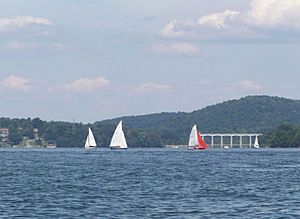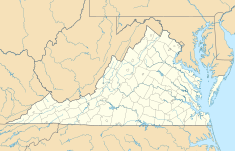Claytor Dam facts for kids
Quick facts for kids Claytor Dam |
|
|---|---|

Claytor Lake just above the dam
|
|
|
Location of Claytor Dam in Virginia
|
|
| Country | United States |
| Location | Pulaski County, Virginia |
| Coordinates | 37°4′31.23″N 80°35′5.53″W / 37.0753417°N 80.5848694°W |
| Purpose | Power |
| Status | Operational |
| Opening date | 1939 |
| Dam and spillways | |
| Type of dam | Gravity |
| Impounds | New River |
| Height | 145 ft (44 m) |
| Length | 1,142 ft (348 m) |
| Spillways | 9 sluice gates |
| Spillway type | Controlled, crest overflow |
| Reservoir | |
| Creates | Claytor Lake |
| Total capacity | 225,000 acre⋅ft (278,000,000 m3) |
| Surface area | 4,472 acres (1,810 ha) |
| Maximum length | 21.67 mi (34.87 km) |
| Maximum water depth | 115 ft (35 m) |
| Normal elevation | 1,846 ft (563 m) |
| Power station | |
| Commission date | 1939 |
| Turbines | 4 x 18.75 MW Francis-type |
| Installed capacity | 75 MW |
The Claytor Dam is a large structure built on the New River in Pulaski County, Virginia, United States. It is located about 2.5 mi (4.0 km) south of Radford. This dam is very important because it helps create electricity. It also forms a huge lake called Claytor Lake, which is a popular spot for fun activities.
The dam is named after William Graham Claytor. He was a vice president at Appalachian Power Company (APC) and played a big part in getting the dam built. Today, APC is part of American Electric Power (AEP), which owns and operates the dam.
Contents
What is Claytor Dam?
Claytor Dam is a special type of dam called a gravity dam. This means it uses its own heavy weight to hold back the water. It's like a giant, solid wall that stands strong against the force of the river.
Key Facts About the Dam
- The dam is 1,142 ft (348 m) long. That's longer than three football fields!
- It stands 145 ft (44 m) tall. Imagine a 14-story building!
- The dam has nine sluice gates. These are like big doors that can open and close to control how much water flows through.
How Claytor Dam Makes Electricity
The main job of Claytor Dam is to make hydroelectric power. This is a clean way to create electricity using the power of moving water.
The Power Station
- The dam supports a power station that can produce 75 MW of electricity.
- It has four special machines called Francis-type turbines. These turbines spin when water rushes through them.
- When the turbines spin, they turn generators that create electricity.
- The power station started making electricity in 1939.
The Process of Hydroelectric Power
1. Water from the New River is held back by the dam, forming Claytor Lake. 2. When electricity is needed, water is released from the lake. 3. This water flows through large pipes called penstocks. 4. The rushing water spins the turbines inside the power station. 5. The spinning turbines power generators, which produce electricity. 6. The electricity is then sent out through power lines to homes and businesses.
Claytor Lake: A Place for Fun
The reservoir created by Claytor Dam is called Claytor Lake. It's not just for making power; it's also a very popular place for people to visit and enjoy outdoor activities.
Lake Size and Features
- Claytor Lake holds a lot of water: 225,000 acre⋅ft (278,000,000 m3).
- The lake covers a huge area of 4,472 acres (1,810 ha).
- It stretches for 21.67 mi (34.87 km) behind the dam.
- At its deepest point, the lake is about 115 ft (35 m) deep.
Recreation at the Lake
People love to visit Claytor Lake for many reasons:
- Boating: You can see all kinds of boats, from small fishing boats to speedboats and sailboats.
- Fishing: The lake is home to many types of fish, making it a great spot for anglers.
- Swimming: On hot days, people enjoy swimming in the lake's cool waters.
- Camping and Picnics: There are parks and campgrounds around the lake where families can spend time outdoors.
Claytor Lake is a great example of how a dam can serve multiple purposes, providing both essential power and a wonderful place for recreation.


